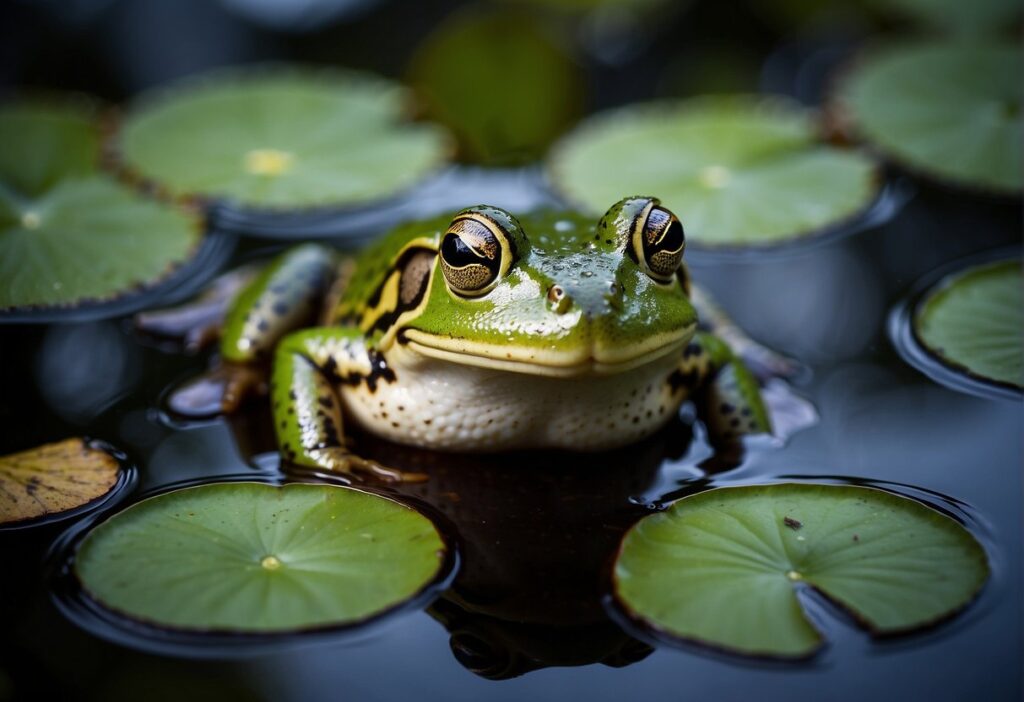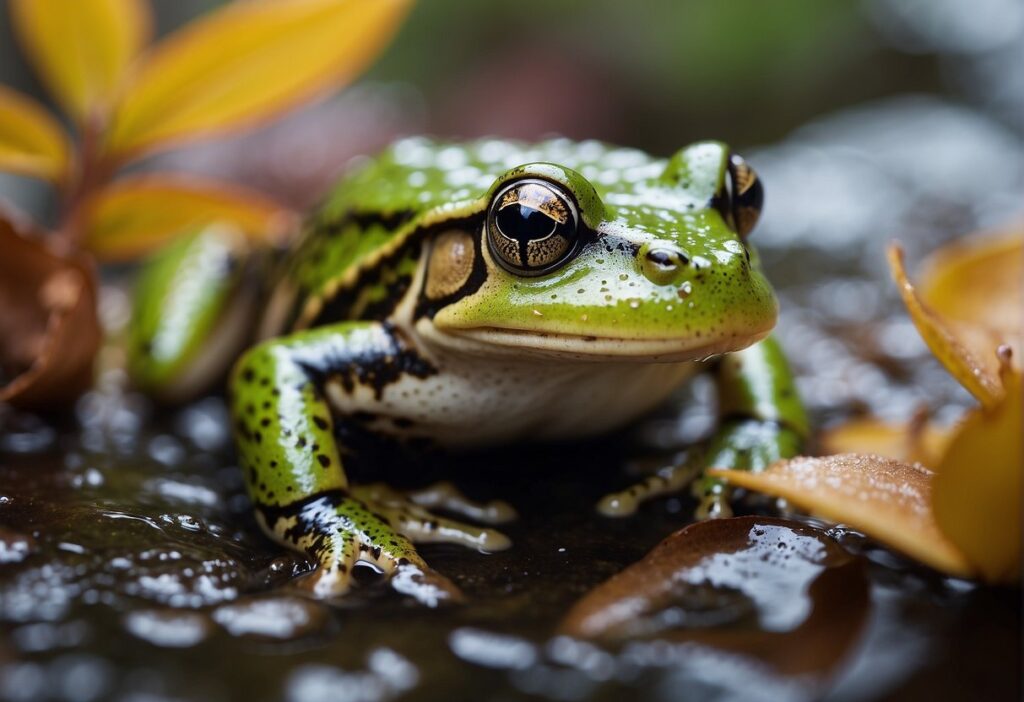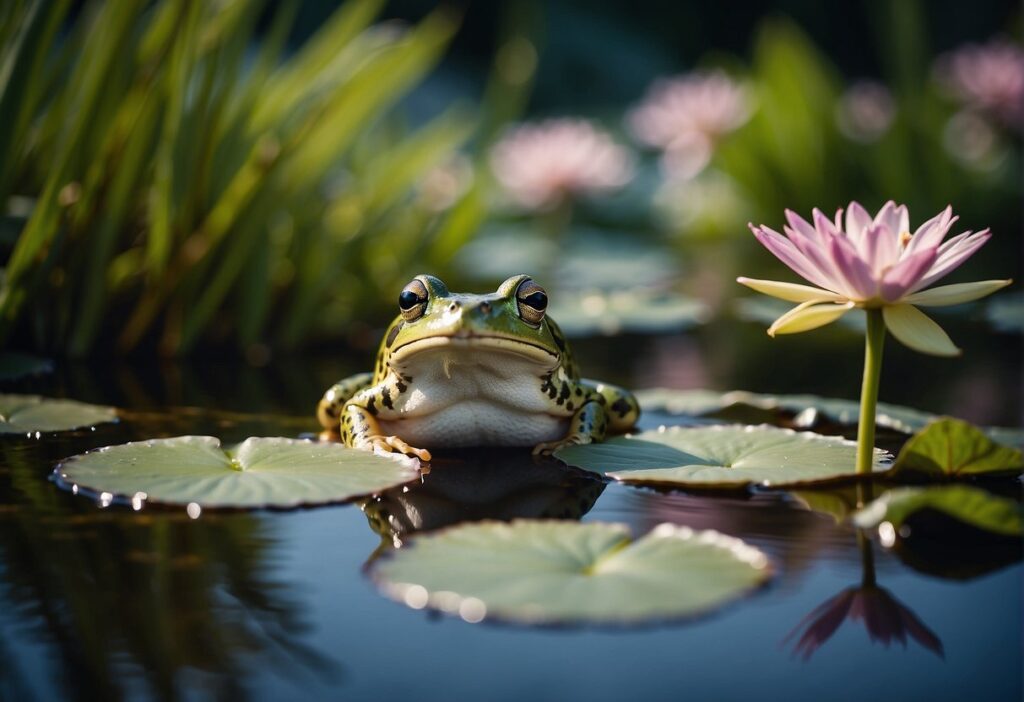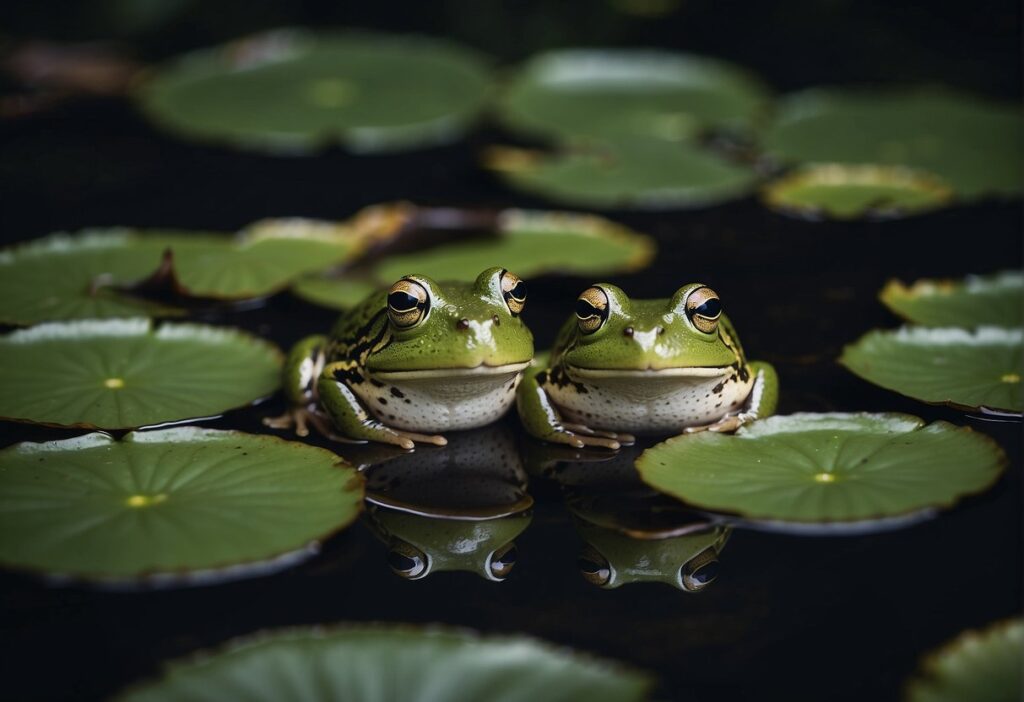Do you ever wonder where frogs go to sleep? Unlike humans, frogs do not have eyelids, so it can be difficult to tell when they are resting. In this article, we will explore the sleeping habits of frogs and answer some frequently asked questions about their behavior.

Understanding frog sleep can be a bit tricky because it is different from that of humans and other mammals. Frogs do not experience the same stages of sleep that we do, and they do not have a designated sleeping area like a bed or den. Instead, they rest in a variety of places and positions depending on their habitat and behavior.
Let’s dive into the world of frog sleep and explore where these fascinating creatures rest their heads.
Key Takeaways
- Frogs do not sleep like humans or other mammals and do not have a designated sleeping area.
- Frogs rest in a variety of places and positions depending on their habitat and behavior.
- Understanding frog sleep requires a different perspective than that of human sleep.
Understanding Frog Sleep
Frogs are a type of amphibian that have unique sleep patterns compared to mammals and birds. In this section, we will explore the various aspects of frog sleep, including defining sleep in frogs and the different sleep stages they experience.

Defining Sleep in Frogs
The definition of sleep in frogs is different from that of mammals. While mammals experience both active and quiet sleep stages, frogs only experience a quiet sleep stage. This means that their brain activity is reduced, but they are still able to respond to external stimuli.
Additionally, the definition of sleep in frogs has been based on a mammal-centric definition of sleep. This means that the sleep patterns of frogs have not been extensively studied, and there is still much to learn about their sleep behavior.
Sleep Stages in Frogs
Frogs experience two main sleep stages: non-REM sleep and quiet sleep. During non-REM sleep, the frog’s brain waves slow down and their muscle activity decreases. This stage is similar to the quiet sleep stage in mammals.
During quiet sleep, the frog’s brain activity is reduced even further, and they become less aware of their environment. However, they are still able to respond to potential threats, conserving energy for their nocturnal endeavors.
While it is still unclear whether frogs experience REM sleep, some studies suggest that they may exhibit similar brain wave patterns during certain stages of sleep. However, further research is needed to confirm this.
Frog Behavior and Sleep
Frogs are fascinating creatures that exhibit unique behaviors, including their sleeping patterns. In this section, we will explore the daily rhythms and activity of frogs, as well as their physical states during rest.
Daily Rhythms and Activity
Frogs are primarily active at night, making them nocturnal animals. During the day, they tend to rest and conserve their energy. This behavior is essential because it helps the frogs avoid predators that are active during the day.
Frogs are also known to be alert during their resting periods, even when they are asleep. They have a nictitating membrane, which is a transparent eyelid that protects their eyes while still allowing them to see. This membrane helps frogs stay alert and aware of their surroundings, even when they are sleeping.
Physical States During Rest
When frogs rest, they enter a sleep-like state of rest. This state is different from how mammals sleep. Frogs remain still and close their eyes during resting, but they remain alert.
Recent scientific studies have found evidence to prove that frogs sleep based on intermediate periods of Non-REM, Primary, and Cataplectic Sleep. During this time, their body temperature, heart rate, and breathing rate decrease, and they enter a state of rest.
Although frogs are capable of sleeping, their sleeping patterns and positions vary depending on their species and environment. Some aquatic frogs will live, sleep, and hibernate in water, while terrestrial frogs will live, sleep, and hibernate on or under the ground.
Frog Habitats and Resting Places
Frogs are found all around the world, and they inhabit a wide range of environments, from forests to deserts, and from water to land. In this section, we will explore the different types of habitats and resting places that frogs use.
Aquatic and Semi-Aquatic Frogs
Aquatic frogs are those that spend most of their lives in or near water. These include species such as the wood frog, green frogs, northern leopard frogs, and the American bullfrog. Aquatic frogs will typically rest and sleep in the water, hiding among vegetation or rocks to avoid predators. Semi-aquatic frogs, such as the bullfrog, may also rest on the banks of rivers or ponds, but they will always stay close to the water.
Terrestrial and Arboreal Frogs
Terrestrial and arboreal frogs are those that live on land. These include species such as the arboreal frog and terrestrial frog. Terrestrial frogs will typically rest and sleep underground, in burrows or under rocks, to escape the heat of the sun and avoid predators. Arboreal frogs, on the other hand, will rest and sleep in trees, using their sticky feet to cling to branches and leaves.
Adaptations for Survival
Frogs have a variety of adaptations that help them survive in their environment. These adaptations can be physical or behavioral and are essential for their survival. In this section, we will discuss some of the most important adaptations that frogs have developed over time.

Physical Adaptations
Frogs have developed a number of physical adaptations that help them survive. One of the most important is their skin. Frogs have a thin, moist skin that helps them breathe and absorb water. This skin also helps protect them from predators. Some frogs have developed bright colors or patterns on their skin as a warning to predators that they are poisonous or dangerous.
Frogs also have nictitating membranes, which are transparent eyelids that protect their eyes while they are underwater. This allows them to hunt and avoid predators without damaging their eyes. Frogs also have excellent hearing and can detect the slightest sounds, which helps them avoid predators and find prey.
Behavioral Adaptations
Frogs have developed a number of behavioral adaptations that help them survive. One of the most important is their ability to change color. Some frogs can change color to blend in with their surroundings, making them difficult to spot by predators. Other frogs have developed the ability to play dead, which can help them avoid predators.
Frogs are also very alert and can detect even the slightest movement. This helps them avoid predators and hunt prey. Some frogs are ambush predators, waiting for their prey to come to them, while others actively hunt for their food.
Finally, frogs have developed the ability to remain immobile for long periods of time. This can help them avoid predators or wait for prey to come within striking distance. Some frogs also have the ability to hibernate during the winter, which helps them survive in colder climates.
Seasonal Changes and Frog Sleep
Frogs’ sleep patterns can be affected by seasonal changes in temperature, food availability, and metabolic rate. Some species of frogs, such as the leopard frog and spring peeper, hibernate during the winter months to conserve energy.

Hibernation and Brumation
During hibernation, frogs lower their metabolic rate and brain temperature, which allows them to conserve energy and survive the colder temperatures. Brumation is similar to hibernation but occurs in reptiles and some amphibians.
Estivation and Summer Dormancy
In the summer months, some species of frogs enter a state of estivation or summer dormancy. This allows them to conserve energy during hot and dry periods when food and water are scarce.
During estivation, frogs lower their metabolic rate and become less active. They may also bury themselves in the ground to avoid dehydration.
Overall, frogs’ sleep patterns are influenced by a variety of factors, including temperature, food availability, and seasonal changes. By entering states of hibernation, brumation, estivation, or summer dormancy, frogs can conserve energy and survive in challenging environments.
Research and Discoveries

Scientific Studies on Frog Sleep
Frog sleep is a fascinating topic that has been studied by many scientists. Some older studies report that frogs do not sleep at all, yet more recent studies have clearly outlined the reasons why frogs do sleep and how. According to Karmanova (1982), who discovered primary sleeping methods employed by frogs (CTNF), frogs sleep differently compared to humans and other mammals. Typical sleep characteristics have been observed in most animals, such as mammals like humans and birds.
Piéron, a French psychologist, concluded that all mammals, birds, and reptiles sleep. He arrived at this conclusion through observations in his laboratory back in 1913. Piéron developed criteria for defining the behavioral state of sleep. However, it was not until the 1950s that the discovery of paradoxical sleep in mammals led to the realization that sleep was not a uniform state.
Comparative Analysis with Other Species
Frogs are vertebrates, which means they have a backbone and are ectothermic, meaning they rely on their environment to regulate their body temperature. American toads are an example of a species that has been studied in comparison to frogs. A study conducted by the Department of Biology at the University of Victoria found that American toads exhibit a form of catatonic sleep, which is characterized by the complete absence of muscle tone.
Practical Observations

Identifying Sleeping Frogs
If you’re curious about where frogs sleep, you’ll need to know how to identify a sleeping frog. While sleeping, frogs remain motionless and often assume a unique posture. They may tuck their limbs close to their bodies or bury themselves in soil or substrate.
To identify a sleeping frog, look for one that is not moving and appears to be in a resting position. A sleeping frog may also have its eyes closed, although this is not always the case.
Frog Sleep in Natural Habitats
Frogs can sleep in a variety of locations in their natural habitats. They may burrow into soil or substrate, hide under rocks or vegetation, or simply rest on the ground. The location a frog chooses to sleep in may depend on factors such as temperature, humidity, and predator avoidance.
It’s important to note that not all frog species sleep in the same way. Some species may sleep while floating in water or while perched in trees. Additionally, some species may enter a state of torpor rather than true sleep.
Frequently Asked Questions
How do frogs adapt their sleeping habits in different seasons?
Frogs are ectothermic animals, which means that their body temperature is regulated by the environment. Therefore, their sleeping habits vary depending on the temperature and weather conditions. During the colder months, frogs tend to hibernate in burrows, under rocks, or in the mud at the bottom of ponds to conserve energy. In warmer months, they may sleep in more exposed areas like on leaves or in vegetation.
What are the common resting places for frogs during the daytime?
Frogs are most active at night, so during the day they will often rest in shaded areas to avoid the heat of the sun. They may rest on leaves, in vegetation, or in burrows. Some species of frogs will also rest on rocks or logs near water sources.
Are there specific sleeping positions or locations frogs prefer at night?
Frogs do not have a specific sleeping position, but they will often rest on leaves or in vegetation near water sources. Some species of frogs may also burrow into the mud at the bottom of ponds to rest.
Is it possible for frogs to sleep submerged in water, and how does that work?
Yes, some species of frogs can sleep submerged in water. They are able to do this by absorbing oxygen through their skin. They may also rest on the surface of the water with their nostrils exposed to breathe air.
Do frogs exhibit any unique behaviors while sleeping, such as eye movement?
Frogs do not exhibit rapid eye movement (REM) sleep like mammals do. However, they may twitch or move slightly while sleeping, which is thought to be a response to external stimuli.
In what ways do frogs’ sleeping patterns vary from other amphibians?
Frogs’ sleeping patterns can vary depending on the species and the environment they live in. Some species of frogs may sleep for longer periods of time during the day, while others may be more active during the day and sleep at night. Additionally, some species of amphibians may not sleep at all, while others may enter a state of torpor to conserve energy.
